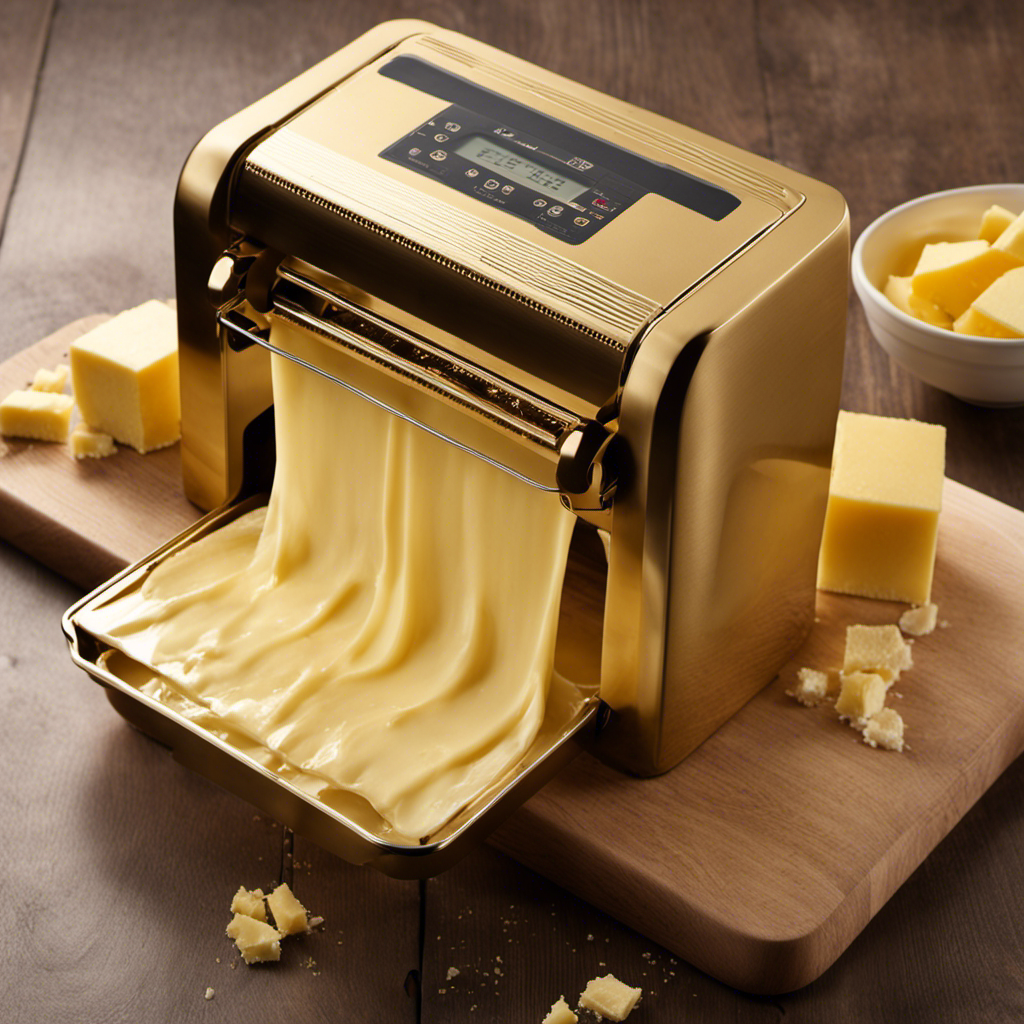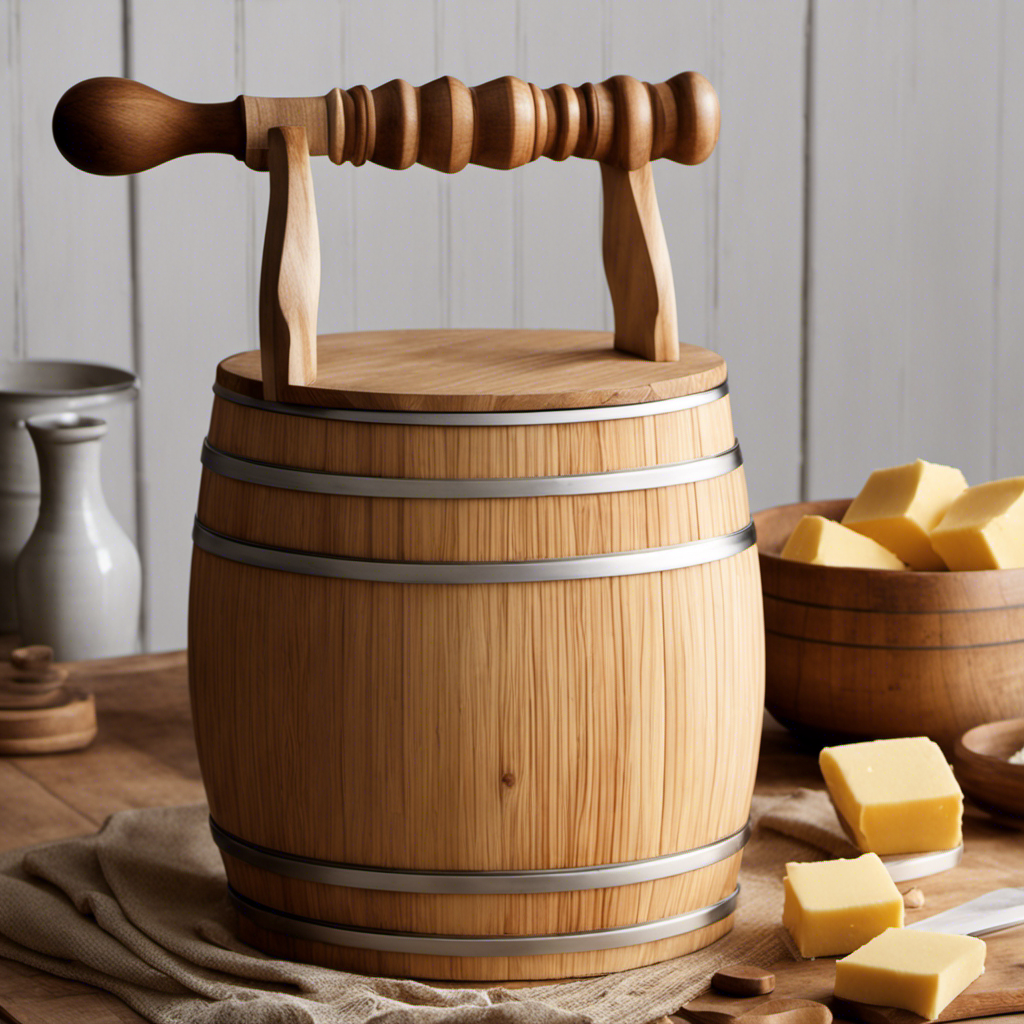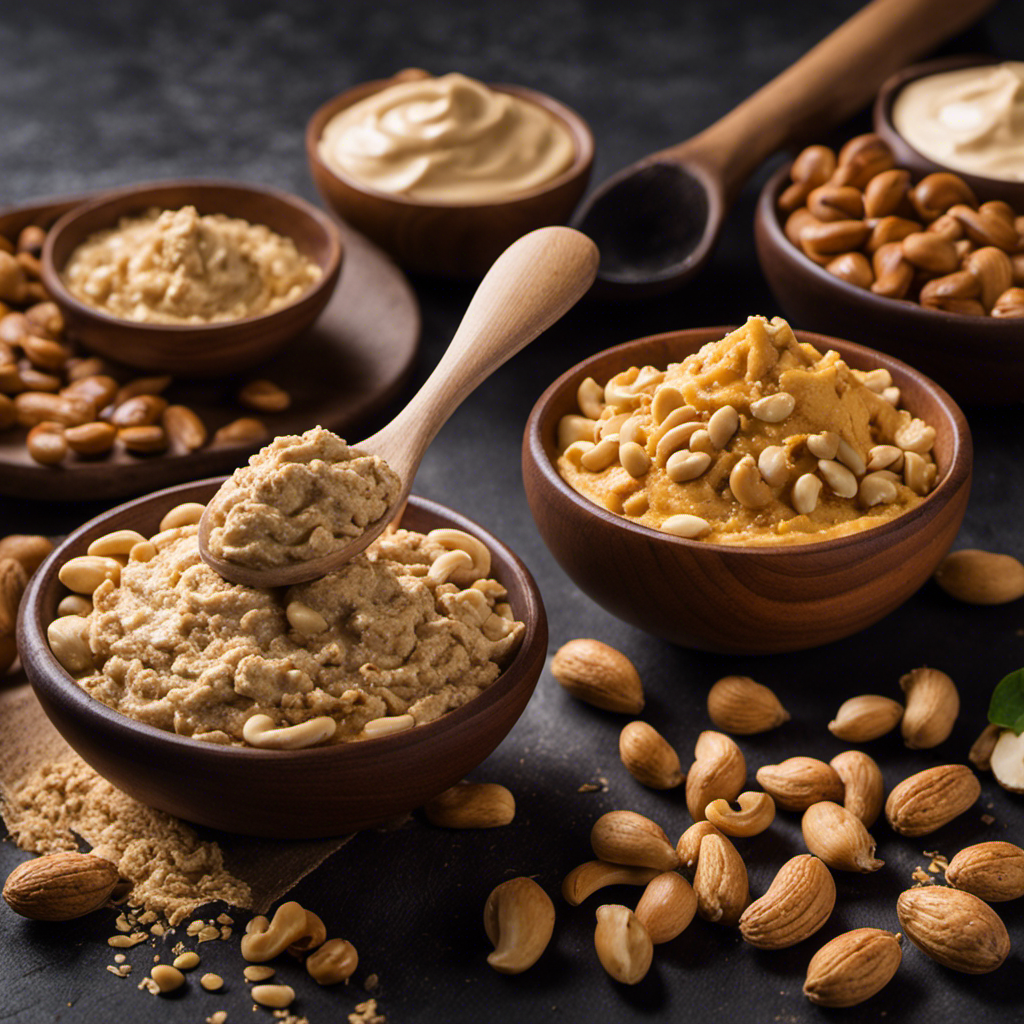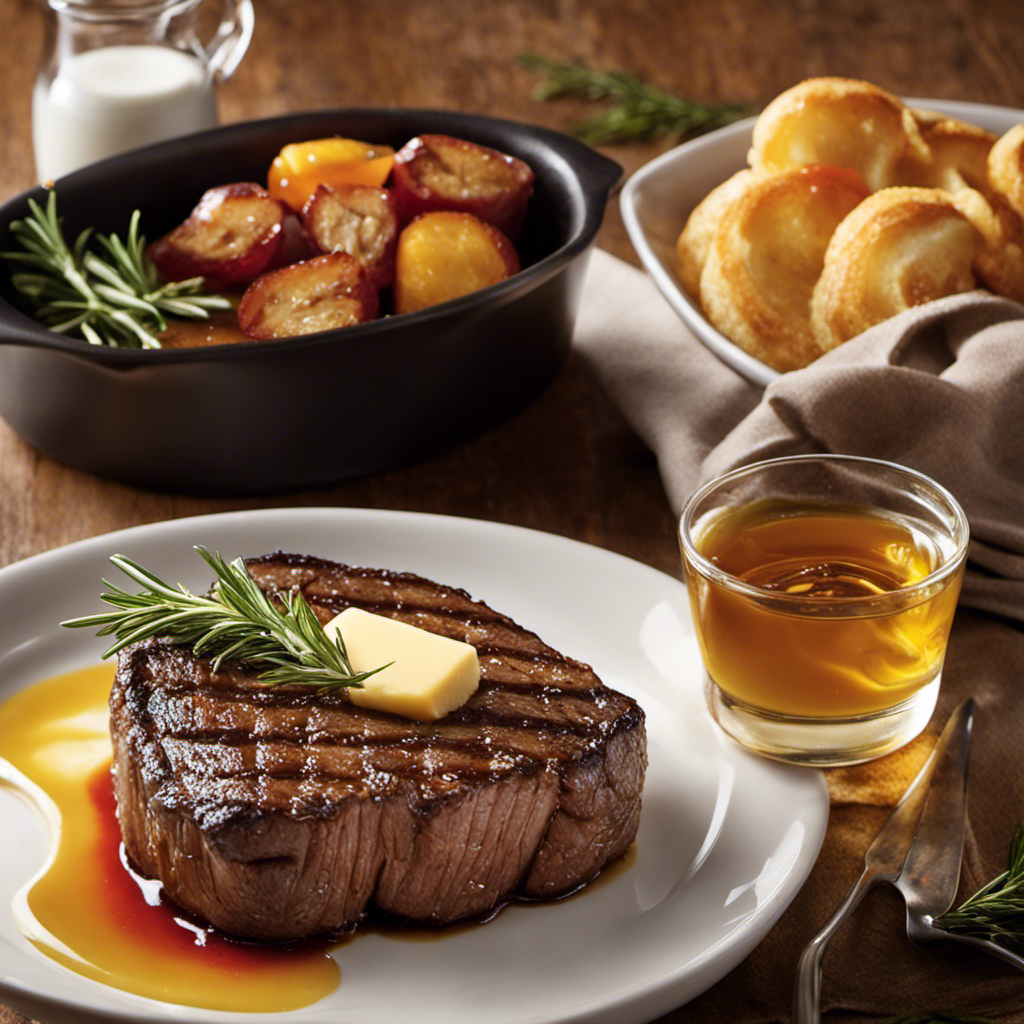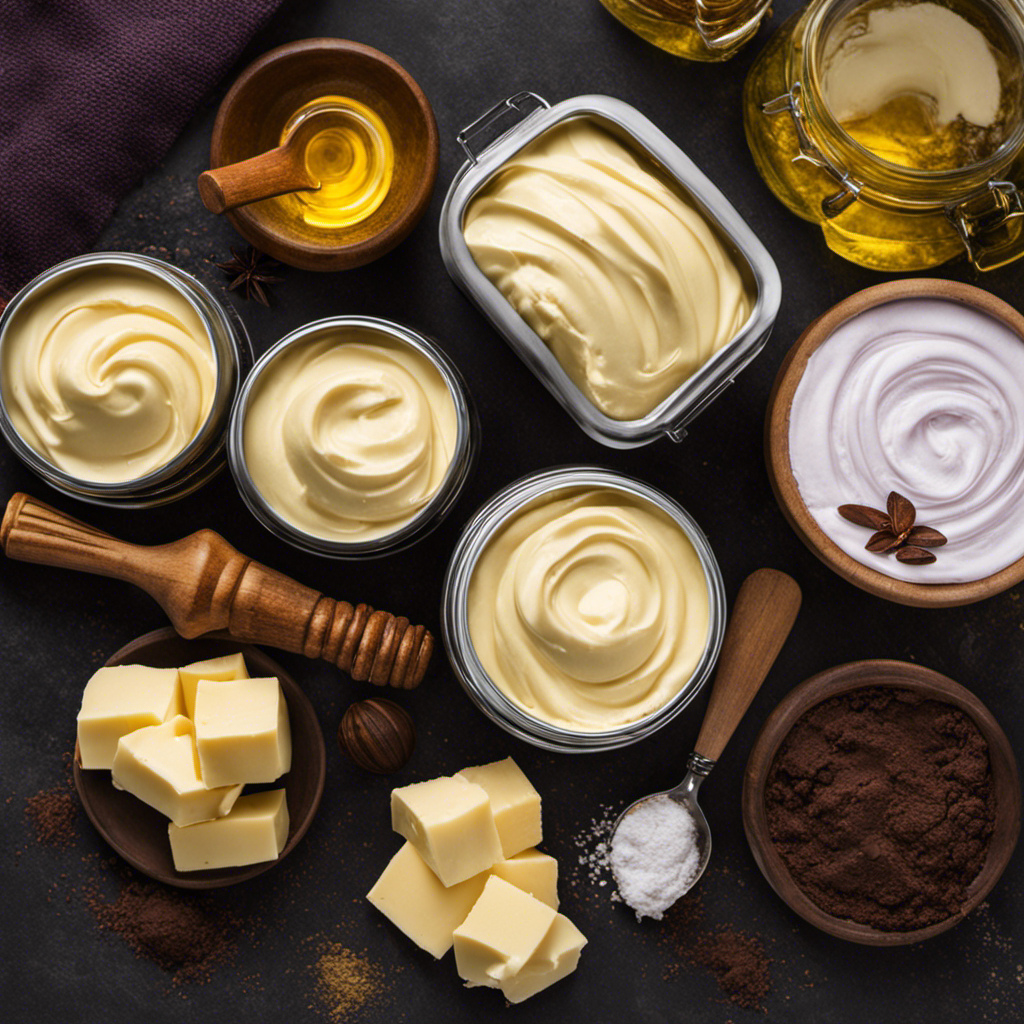I have always been a fan of butter, but recently I found a new way to enjoy it: dehydrated butter. This easy method turns regular butter into a convenient and versatile ingredient that can be used in a variety of culinary creations.
In this article, I’ll guide you through the step-by-step process of dehydrating butter, from selecting the right butter to monitoring the dehydration process. Get ready to elevate your cooking game with this innovative technique.
Key Takeaways
- Choose unsalted butter with high fat content for better results.
- Consider flavor preferences and intended use when choosing butter.
- Adjust time and temperature to achieve desired texture and consistency during the dehydrating process.
- Dehydrated butter adds a rich and buttery flavor to baked goods and savory dishes.
Preparing the Butter
Now, you’re going to start preparing the butter by melting it in a saucepan. To ensure the best results, it’s important to choose the right butter for dehydration. Look for unsalted butter with a high fat content, as this will yield a more concentrated and flavorful end product.
Once the butter is melted, let it cool slightly before transferring it to a container for storage. It’s crucial to store the butter in an airtight container to prevent moisture absorption, which can lead to spoilage.
Place the container in the refrigerator to solidify the butter before continuing with the dehydration process. Proper butter storage and preservation techniques will ensure the quality and longevity of the dehydrated butter.
Choosing the Right Butter
When you’re selecting the right kind of butter, make sure to consider the fat content and salt levels. Butter quality plays a crucial role in achieving the desired flavor and texture in your dishes. To make an informed choice, it’s important to understand your flavor preferences and the different types of butter available. Here is a breakdown of the key factors to consider:
| Butter Type | Fat Content | Salt Level |
|---|---|---|
| Unsalted Butter | Higher fat content | No salt added |
| Salted Butter | Lower fat content | Salt added |
| Cultured Butter | Varies | Varies |
Unsalted butter, with its higher fat content, is ideal for baking and allows you to control the salt levels in your recipe. On the other hand, salted butter adds a savory element to your dishes and is great for spreading on bread. Cultured butter offers a unique tangy flavor and can enhance the taste of your dishes. Consider your flavor preferences and the intended use of the butter when making your selection.
Slicing the Butter
To slice the butter easily, use a sharp knife and make sure it is at room temperature.
The slicing technique is crucial when preparing butter for the melting process. Begin by placing the butter on a clean, flat surface.
Hold the knife parallel to the surface and apply gentle pressure to the butter. Slowly glide the knife through the butter, maintaining a steady motion. Avoid using a sawing motion, as this can cause the butter to crumble.
If the butter starts to stick to the knife, dip the knife in warm water and wipe it dry before continuing.
Pre-Treatment Options
For optimal results, you should consider pre-treatment options before proceeding with the dehydration process. Pre-treatment techniques can greatly impact the final quality and flavor of dehydrated butter. There are several post-processing techniques and flavor enhancements that can be used to elevate the taste and texture of dehydrated butter.
One common pre-treatment option is to add salt to the butter before dehydration. Salt acts as a flavor enhancer and helps to preserve the butter during the dehydration process. Another technique is to infuse the butter with herbs or spices. This can add unique flavors and aromas to the dehydrated product. Additionally, some people choose to clarify the butter before dehydration. Clarifying removes any impurities and solids, resulting in a purer, smoother final product.
To further illustrate the impact of pre-treatment options on dehydrated butter, here is a table showcasing some common techniques and their effects:
| Pre-Treatment Technique | Effect |
|---|---|
| Salt | Enhances flavor and improves preservation |
| Infusion | Adds unique flavors and aromas |
| Clarification | Results in a purer, smoother final product |
Dehydrating Temperature and Time
You can adjust the dehydrating temperature and time to achieve the desired texture and consistency in your final product. When dehydrating butter, it is important to use the right temperature and time to preserve its flavor.
The ideal temperature for dehydrating butter is around 130°F (54°C). At this temperature, the butter will slowly melt and evaporate its moisture without getting too hot or losing its flavor.
The duration of the dehydration process can vary depending on the thickness of the butter slices or cubes. Generally, it takes around 8-12 hours to fully dehydrate butter. However, it is crucial to monitor the process closely to ensure that the butter is properly dehydrated without becoming overcooked or burnt.
Now, let’s move on to the next section about monitoring the dehydration process.
Monitoring the Dehydration Process
Keep a close eye on the dehydration process to ensure that it is progressing smoothly without any issues. Monitoring the dehydration progress is crucial in maintaining optimal moisture levels in the butter. By regularly checking the moisture content, you can prevent over-dehydration or under-dehydration, which can affect the quality and shelf life of the dehydrated butter. I recommend using a moisture meter to accurately measure the moisture levels. Below is a table that shows the recommended moisture levels for dehydrated butter at different stages of the dehydration process:
| Dehydration Stage | Moisture Levels |
|---|---|
| Initial Drying | 15-20% |
| Intermediate Drying | 5-10% |
| Final Drying | 2-5% |
Remember to adjust the dehydration time and temperature accordingly to achieve the desired moisture levels. Regularly monitoring the dehydration progress will help you produce high-quality dehydrated butter with optimal moisture content.
Storing Dehydrated Butter
Now that we have discussed the monitoring process of dehydrating butter, let’s move on to storing dehydrated butter.
Storing dehydrated butter is a convenient way to have a long-lasting supply of this essential ingredient. Here are some key benefits of dehydrated butter:
-
Extended Shelf Life: Dehydrated butter can be stored for up to two years without refrigeration, making it an excellent option for long-term storage.
-
Convenience: Having dehydrated butter on hand means you can easily incorporate it into your recipes without worrying about the need for refrigeration or softening.
-
Space-saving: Dehydrated butter takes up significantly less space than its original form, allowing you to store a larger quantity in a smaller area.
-
Versatility: Dehydrated butter can be rehydrated and used in various recipes, such as baking, cooking, or spreading on toast.
Rehydrating Dehydrated Butter
Rehydrating dehydrated butter is a simple process that involves adding water and allowing it to sit for a few minutes.
To begin, fill a container with the desired amount of dehydrated butter. Next, add water to the container, using a ratio of 1 part water to 1 part butter. The water should be at room temperature to ensure proper rehydration.
Stir the mixture gently, making sure all the butter is submerged in the water. Let it sit for approximately 5 minutes, allowing the butter to absorb the water and regain its original consistency.
After the designated time, stir the mixture once again to ensure even distribution of moisture. The rehydrated butter can now be used in any recipe that requires butter. This method of rehydration preserves the flavor of the butter while restoring its creamy texture.
Culinary Uses for Dehydrated Butter
I love using dehydrated butter in my culinary creations because of its versatility in recipes and long shelf life.
Dehydrated butter can be used in a variety of dishes, from baked goods to savory dishes, adding a rich and buttery flavor.
Additionally, its long shelf life allows me to always have butter on hand, even when fresh butter is not readily available.
Versatility in Recipes
When using dehydrated butter, you can discover its versatility in various recipes. Here are four ways dehydrated butter can enhance your cooking experience:
-
Baking: Dehydrated butter can be used in place of regular butter in baking recipes, providing the same rich, creamy flavor without the added moisture. It is especially useful in recipes that require a dry consistency, like pie crusts or cookies.
-
Sauces and gravies: Dehydrated butter can be easily rehydrated and used as a thickening agent in sauces and gravies. It adds a buttery richness and smooth texture to your dishes.
-
Seasoning: Dehydrated butter can be mixed with herbs, spices, and other seasonings to create a flavorful compound butter. Spread it on bread, melt it over vegetables, or use it to top grilled meats for an extra burst of flavor.
-
Popcorn topping: Sprinkle dehydrated butter powder over freshly popped popcorn for a delicious and convenient buttery topping. It evenly coats the popcorn and adds a savory taste.
With its ability to be used in a variety of cooking techniques and as an alternative ingredient, dehydrated butter is a valuable addition to any kitchen.
Long Shelf Life
To maintain its freshness and extend its shelf life, you should store dehydrated butter in an airtight container.
Dehydrated butter is a convenient way to preserve butter flavor while increasing its shelf life. Proper storage is crucial to ensure the longevity of dehydrated butter.
An airtight container prevents moisture and air from entering, which can cause the butter to spoil or lose its flavor. Additionally, storing dehydrated butter in a cool and dark place helps maintain its quality.
It is important to note that dehydrated butter should be used within a reasonable timeframe to ensure optimal taste and texture. By following these storage guidelines, you can enjoy the preserved butter flavor of dehydrated butter for an extended period.
Frequently Asked Questions
Can I Use Salted Butter for Dehydrating?
Yes, I can use salted butter for dehydrating. However, it is recommended to use unsalted butter for dehydrating butter with spices. Using unsalted butter allows for better control of the salt content in the final product.
How Long Does It Take to Dehydrate Butter?
Dehydrating butter can be a time-consuming process. It took me about 6 hours to dehydrate a stick of butter. Once dehydrated, the best method for storing is in an airtight container. To rehydrate, simply add water and mix until smooth.
Can I Use a Microwave to Dehydrate Butter?
I prefer using the oven over the microwave for dehydrating butter because it provides a more even and controlled heat. Additionally, dehydrated butter can be used as a flavoring agent in various dishes.
Can I Dehydrate Clarified Butter?
Yes, clarified butter can be dehydrated. It has a longer shelf life than regular butter, making it a good option for dehydration. Dehydrated butter can be used as a flavor enhancer in soups, sauces, and even baked goods.
Can Dehydrated Butter Be Used in Baking Recipes?
Substitutes for dehydrated butter in baking recipes include using vegetable oil, coconut oil, or applesauce. To rehydrate dehydrated butter for baking, simply add water and mix until desired consistency is reached.
Conclusion
In conclusion, dehydrating butter is a simple yet effective way to extend its shelf life and add a unique twist to your culinary creations. By following the proper steps and techniques outlined in this article, you can successfully dehydrate butter and unlock a world of possibilities in your cooking.
So why not give it a try and let your dishes spread their wings with the rich and concentrated flavors of dehydrated butter? The proof is in the pudding, or in this case, the butter!
